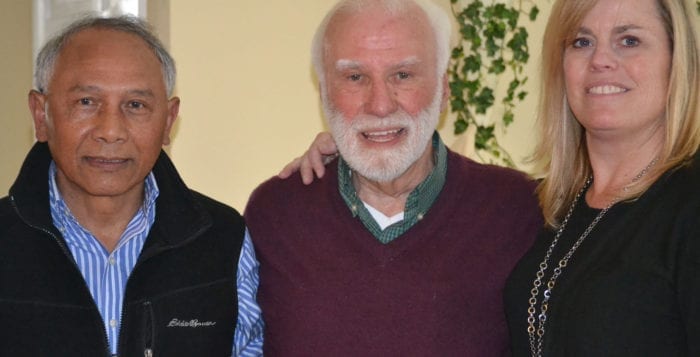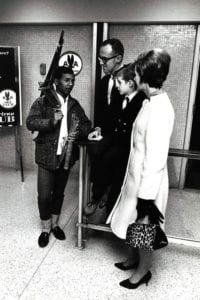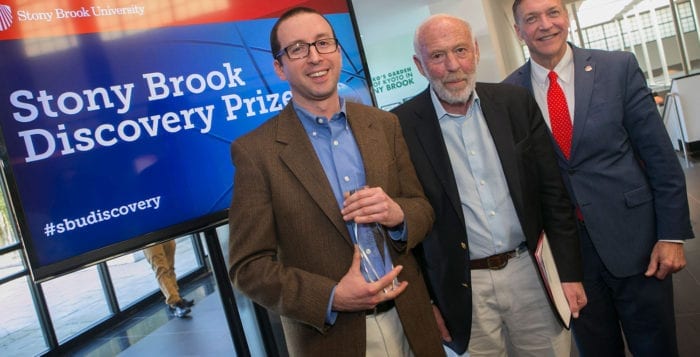Life is filled with various milestones. When the students at Imagination Pre-School in Stony Brook graduate June 19, owner, director and teacher Eileen Hummel will also be stepping into a new stage of her life.
A couple of months ago, Hummel, who owns the pre-school with her husband Sol, sent a letter out to parents notifying them the pre-school will be closing after 20 years. The owner said it wasn’t a decision she and her husband were planning on making in the near future, but when Unitarian Universalist Fellowship, the building’s owners she leases the space from at 380 Nicolls Road, decided they wanted to utilize the building for their own needs, and no longer wanted tenants, the Hummels decided it was time to move on.
It was in June of 1997 when the doors to the school officially opened. Hummel had 20 years of experience in the education field, which included seven years as a director and head teacher at a local private school. Through the years, she estimates over 2,500 have come through the school’s door not only for pre-k classes, but summer camp, too.
The location has been an ideal one, especially with Stony Brook University right down the road.

“We chose it because at the time we felt it was a perfect location being on Nicolls Road, which is a well-traveled road, and we knew someone who belonged to the fellowship — one of my neighbors — and it seemed like a very good fit at the time,” the teacher said.
Danielle Short, 21, who is currently a junior at Salisbury University in Maryland majoring in respiratory therapy, was surprised when she heard the news. The former student, who also worked as a camp counselor at Imagination, said she still keeps in touch with a couple of people she made friends with there.
“I was surprised because the school was open for so long, and it’s a really popular school in the area — a lot of people go there,” Short said.
Elizabeth Avella, 23, who also attended the school and would often visit her mother who worked there, was also saddened by the news.
“It makes me sad because I went there — all my brothers went there, my mom works there, so it’s close to home,” she said. “It’s sad to see a place like that go.”
Hummel, who holds a master’s degree in early childhood education, created a pre-school where children can socialize and learn in a fun environment. She said one of her favorite things to do, and among the things she’ll miss most, is dressing up for holidays and special occasions. Through the years, she has played Santa’s helper and a leprechaun for St. Patrick’s Day, among other characters for the children.
“She dresses up for the holidays and everything,” Short said. “She’s always very spirited at the events.”
Hummel said in addition to missing special occasions with her students, she’ll miss the everyday running of the school, which included greeting parents and grandparents as they dropped their children off.
“I loved owning a pre-school, and I loved interfacing with the families,” she said.

While Hummel had created an entertaining environment for her students, who range in age from 2 to 4 years old, there was also a lot of learning going on both in scholastics and life skills.
“My philosophy is, especially for 2-year-olds and 3-year-olds, socialization is the most important thing,” Hummel said. “For the 4-year-olds, the academics to get them ready for school is as important as the socialization.”
She said 4-year-olds learned the alphabet and numbers. And no matter a child’s age, Hummel said she and the teachers felt it was important to teach good values, how to be polite and kind, and how to make friends. In addition to the basics, it’s most important for young students “to be able to love school and want to go to school every day,” she said.
Jenna Stimmel, 20, another former student who worked at the summer camp, remembers playing games at the pre-school. The former student said she met one of her best friends there.
“It’s so cool to have met someone in pre-school and still talk to them now,” Stimmel said.
For Stimmel, who is now a sophomore majoring in psychology at Binghamton University, it was a pleasure to work for her former pre-school as a camp counselor, and work with the children. She said it was heartwarming to see the kids look up to her as she had to her teachers and counselors.
“It was really cool to get to work with [the counselors] because I’ve seen them as a child and now I get to work with them,” she said.
Avella, who now works in the corporate design industry, remembers how sweet Miss Eileen was when she attended the school, and her first day of school when her teacher helped her get through the day.
“I remember my first day of school,” Avella said. “I was crying, and I remember the teacher Miss Denise was holding me all day, and she wouldn’t put me down.”
Like Stimmel, Avella made friends at the school and still keeps in touch with them and the teachers. When her mother used to be a teacher, she would volunteer to help her mother at the school.

“I’m glad I got the opportunity to go there,” Avella said. “You wouldn’t think pre-school would be so important, or that it would last this long. I mean, I’m 23, and I still talk to my pre-school teacher. That’s pretty cool.”
As she says goodbye to Imagination Pre-School, Hummel doesn’t plan to rest. She hopes to become involved with an organization that works with children on a volunteer basis. However, her school will always hold a special place in her heart.
“It was a huge part of my life the last 20 years, and I will miss interacting with the children, with the families,” she said.
Her former students hope she’ll enjoy her retirement.
“I feel like she’s been working so hard for so many years,” Stimmel said. “She was an incredible person to get to work with. She’s such an incredibly hard-working person, and I think that this retirement is well-deserved for her.”
Avella hopes Hummel will continue her career in childcare in some shape or form.
“I hope that she does what she loves still, and she can find a way to still incorporate kids into her life, and bring joy to kids, because I loved going there,” Avella said. “Everyone that works there is a family, so I hope she’s still able to do that. I hope she’s able to still bring joy to people’s lives.”
































